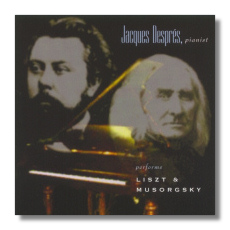
The Internet's Premier Classical Music Source
Related Links
- Liszt Reviews
- Latest Reviews
- More Reviews
-
By Composer
-
Collections
DVD & Blu-ray
Books
Concert Reviews
Articles/Interviews
Software
Audio
Search Amazon
Recommended Links
Site News
 CD Review
CD Review
Franz Liszt

Piano Works
- Variations on Bach's Weinen, Klagen, Sorgen, Zagen
- Variations on Bach's B minor Mass
- Csardas macabre
- Trübe Wolken
- Élégie
- Nocturne "En reve"
- Abschied
- Modest Mussorgsky: Pictures at an Exhibition
Jacques Després, piano
Eroica JDT 3004 1997 DDD 77:55
With this release, the small but growing catalog of titles from Eroica Classics now includes a short collection of Liszt piano pieces and the much heralded Pictures at an Exhibition by Mussorgsky as played by the young Canadian pianist Jacques Despres. I must state right off that there is much to cherish in Despres' handling of the Liszt material.
Liszt the composer could generate trite bombast or sublime rhetoric with equal ease. The works presented on this CD suggest both tendencies. Listeners expecting to hear a paraphrase of Bach in the opening selection will be disappointed, with nearly 20 minutes of pure Lisztian "over the top"oratory. However, things improve markedly with the deliciously edgy Csardas macabre which, along with some of the remaining pieces, sound as if they could have been penned quite recently. Despres does a wonderful job evoking the alternately eerie and ambrosial nature of this music. There is some absolutely lovely writing in Élégie, En reve, and Abschied. Liszt proved that he could be author of delicate and captivating tunes in these pieces, and Despres matches the imagination of the composer with his own sensitivity and insight. In my opinion Abschied is the gem of the CD. It is a brief yet totally beautiful and captivating statement. Highest marks to the pianist, who communicates the light and pleasant atmosphere of this farewell to the listener through quaint and gentle musical poetry.
The Mussorgsky Pictures at an Exhibition is one of the first classical music pieces I ever heard, and has remained one of my favorites after many years, in both its original piano cast and also in the renowned Ravel orchestration. Mussorgsky was a highly original talent, largely self-taught. In the midst of his preoccupation with conveying the universal human truth through music ("life, wherever it may be found, the truth however bitter it may be, a bold and sincere language – that is what I aspire to") Mussorgsky composed this piano suite in 1874 as a posthumous tribute to artist Victor Hartmann. The work was not meant as a sentimental reminiscence of the man, but instead a musical response to and characterization of a group of Hartmann watercolors and drawings.
In the creative hands of Mussorgsky, the modest Hartmann sketches were transformed into a vibrant collection of sound pictures. The work begins and is unified by a strolling promenade theme, which walks the listener from one picture to the next. Due to the immense popularity of the orchestral version of Pictures, a pianist tackling the piece needs also to display creative hands, and must combine brilliance of sound, a strong technique and a vivid technicolor imagination. Relative to these points, I must report that our Canadian pianist ultimately disappoints.
Apparently Despres did not wish to impart a showpiece flavor to his intepretation of Pictures. What he gives us is a black and white viewing of Hartmann's sketches, not color. For instance, he does not launch the opening promenade with the degree of boldness I am accustomed to. In fact, his overall conception of the work, when compared to the standard virtuoso treatment (Pletnev, Horowitz, Janis, Jandó and others) is low-key and lacking in dynamism. It is almost as if Despres was intentionally staying as far away from making his ideas sound like an imitation of the orchestral approach to the piece as possible. To me, this was a miscalculation. As another example, the ballet of unhatched chicks is unanimated to the point that one wonders whether the little creatures would indeed ever hatch. The music needs to be more strongly characterized and displayed. For the final Great Gate of Kiev section, Despres' phrasing renders the line unusually choppy, which prevents the piece from achieving its final apotheosis. A word on the piano sound: it is close-in and a bit dry, but robust.
In sum, the disc wins hands down for its beautiful realization of the music of Liszt, but gets low marks in the Mussorgsky. Mr. Despres is an interesting talent who I feel was just not tempermentally suited to Pictures. However, due to his success with the Liszt, I shall look forward to future releases by this artist in more Liszt and to see what he can do in other repertoire.
Copyright © 1998, Peter S. Murano


















